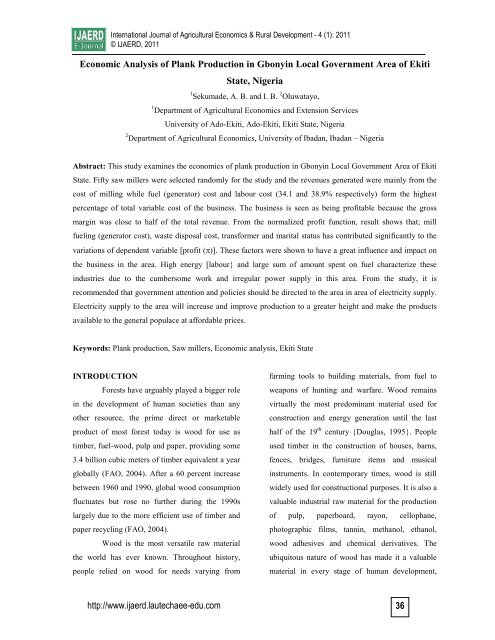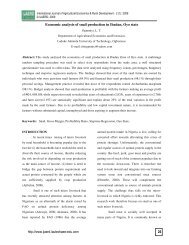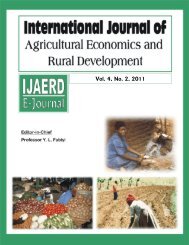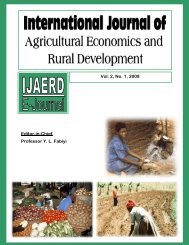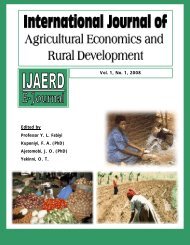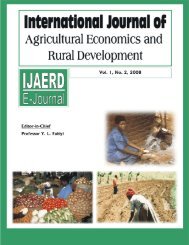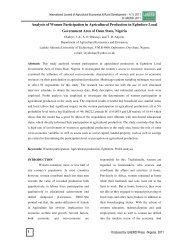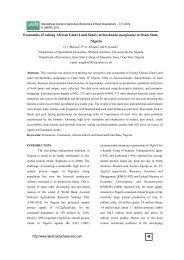Vol 4 No 1 2011
to download the whole journal - Lautechaee-edu.com
to download the whole journal - Lautechaee-edu.com
- No tags were found...
Create successful ePaper yourself
Turn your PDF publications into a flip-book with our unique Google optimized e-Paper software.
International Journal of Agricultural Economics & Rural Development - 4 (1): <strong>2011</strong><br />
© IJAERD, <strong>2011</strong><br />
Economic Analysis of Plank Production in Gbonyin Local Government Area of Ekiti<br />
State, Nigeria<br />
1 Sekumade, A. B. and I. B. 2 Oluwatayo,<br />
1 Department of Agricultural Economics and Extension Services<br />
University of Ado-Ekiti, Ado-Ekiti, Ekiti State, Nigeria<br />
2 Department of Agricultural Economics, University of Ibadan, Ibadan – Nigeria<br />
Abstract: This study examines the economics of plank production in Gbonyin Local Government Area of Ekiti<br />
State. Fifty saw millers were selected randomly for the study and the revenues generated were mainly from the<br />
cost of milling while fuel (generator) cost and labour cost (34.1 and 38.9% respectively) form the highest<br />
percentage of total variable cost of the business. The business is seen as being profitable because the gross<br />
margin was close to half of the total revenue. From the normalized profit function, result shows that; mill<br />
fueling (generator cost), waste disposal cost, transformer and marital status has contributed significantly to the<br />
variations of dependent variable [profit ()]. These factors were shown to have a great influence and impact on<br />
the business in the area. High energy [labour} and large sum of amount spent on fuel characterize these<br />
industries due to the cumbersome work and irregular power supply in this area. From the study, it is<br />
recommended that government attention and policies should be directed to the area in area of electricity supply.<br />
Electricity supply to the area will increase and improve production to a greater height and make the products<br />
available to the general populace at affordable prices.<br />
Keywords: Plank production, Saw millers, Economic analysis, Ekiti State<br />
INTRODUCTION<br />
Forests have arguably played a bigger role<br />
in the development of human societies than any<br />
other resource, the prime direct or marketable<br />
product of most forest today is wood for use as<br />
timber, fuel-wood, pulp and paper, providing some<br />
3.4 billion cubic meters of timber equivalent a year<br />
globally (FAO, 2004). After a 60 percent increase<br />
between 1960 and 1990, global wood consumption<br />
fluctuates but rose no further during the 1990s<br />
largely due to the more efficient use of timber and<br />
paper recycling (FAO, 2004).<br />
Wood is the most versatile raw material<br />
the world has ever known. Throughout history,<br />
people relied on wood for needs varying from<br />
farming tools to building materials, from fuel to<br />
weapons of hunting and warfare. Wood remains<br />
virtually the most predominant material used for<br />
construction and energy generation until the last<br />
half of the 19 th century {Douglas, 1995}. People<br />
used timber in the construction of houses, barns,<br />
fences, bridges, furniture items and musical<br />
instruments. In contemporary times, wood is still<br />
widely used for constructional purposes. It is also a<br />
valuable industrial raw material for the production<br />
of pulp, paperboard, rayon, cellophane,<br />
photographic films, tannin, methanol, ethanol,<br />
wood adhesives and chemical derivatives. The<br />
ubiquitous nature of wood has made it a valuable<br />
material in every stage of human development,<br />
http://www.ijaerd.lautechaee-edu.com 36


